How to Use Social Media for Affiliate Marketing in 2024

Marketer’s Guide to Social Media Affiliate Marketing [+Benefits & Tips]
Using social media for affiliate marketing has become an essential advertising strategy for many businesses. This performance-based strategy benefits content creators by allowing them to integrate affiliate links in their social media posts organically, enables advertisers to promote their products cost-effectively to the right audience without being intrusive and provides end users with product insights through reviews from trusted influencers.
While many affiliate marketers widely use social media affiliate marketing, it is still perceived as unclear territory for businesses and marketers focusing on traditional advertising methods, including social media ads.
In reality, this approach is quite straightforward. Grasping its substantial benefits is crucial for anyone aiming to excel in digital marketing. Meanwhile, advertisers and marketers who have yet to embrace social media for affiliate marketing risk falling behind competitors.
What Is Social Media Affiliate Marketing?
Social media platforms provide a fertile ecosystem for affiliate marketers. Many platforms, including Facebook, LinkedIn, YouTube, TikTok, and Pinterest, allow publishing trackable affiliate links that act as touchpoints in the customer journey. However, affiliate marketing on social media may include other processes than directly publishing affiliate links. For instance, promoting landing pages or social media profiles that contain those links.
Many factors contribute to developing a social media affiliate strategy. The table below outlines the fundamental concepts and terminology used in the industry and discussed in this article.
| Key Players | Advertisers | Businesses seeking to promote their products or services through affiliate links |
| Publishers | Social media influencers and content creators who promote specific products through their social media accounts for financial benefits. Also referred to as product affiliates | |
| Leads | Prospective customers generated by affiliate marketing in social media | |
| Payment Models | Pay per sale | The most popular model allows affiliates to earn a percentage of the sale. Advertisers often prefer this model because it allows paying only when the established goals are completed. A closely related Cost-Per-Action (or Pay-per-Lead) model involves paying for specific actions taken by leads, such as clicking the button or submitting a form. |
| Pay per impressions | Payment is made based on a number of views received by the content with a link. Often used by businesses to raise brand awareness among the auditory of viral social media influencers. | |
| Placement fee | A flat fee paid for the placement of an advertising with an affiliate link on a page with high user traffic. | |
| Promotion Methods | Direct links placement | Traditionally, affiliate marketing involves attaching links to anchors. This approach is preferred for streamlined conversions and simplified payback accounting. |
| Promoting directories with links | Some social media platforms may penalize posts that contain multiple links. An effective way for publishers to overcome these limitations is by promoting web pages that feature optimized affiliate content. Although this approach adds an extra step to the customer journey, it enables the affiliate to attract visitors to their affiliate marketing blogs or other channels. | |
| Affiliate Relationship Frameworks | Affiliate programs | Individual programs set by advertisers to directly manage relationships with the affiliates. Businesses can run social media affiliate programs through their tracking software and third-party affiliate platforms. |
| Affiliate networks | Intermediary networks between publishers and advertisers run by brands or solopreneurs. These platforms communicate with affiliates, provide individual affiliate links, and manage tracking, performance, reporting, and payments. |
What Are the Benefits of Affiliate Marketing Through Social Media?
In 2024, the number of social media user accounts reached 5.17 billion, equivalent to 63.82% of the world’s population. Originally viewed primarily as an entertainment medium, social media has grown to include news broadcasting (Facebook and Twitter), e-learning and hands-on tutorials (YouTube, TikTok), eCommerce (Instagram and Pinterest), and establishing professional connections (LinkedIn).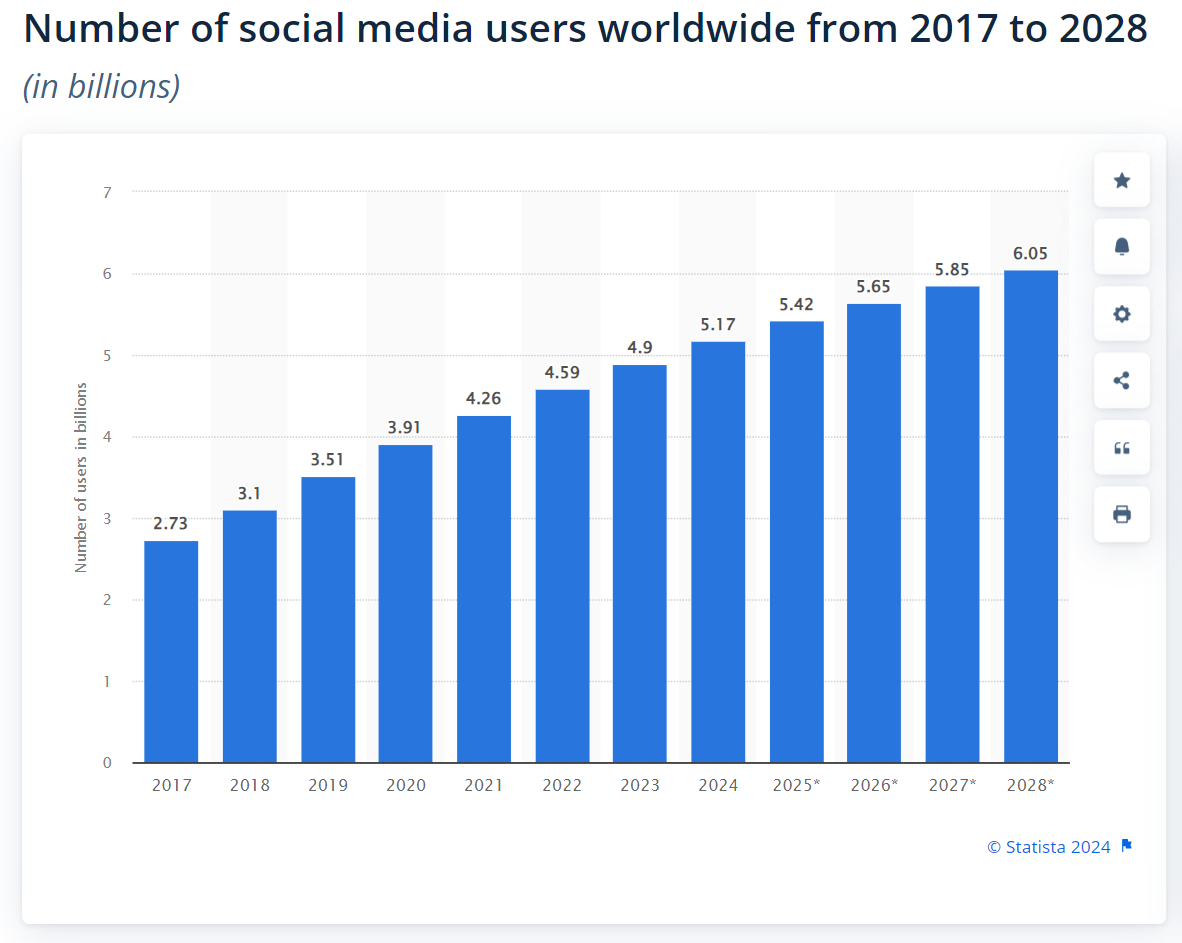
Source: Statista
For users, the appeal of social media platforms compared to traditional media lies in the instant access to vast databases and the ability to switch between the different datasets at their own pace. Conversely, with affiliate marketing, social media offers businesses direct exposure to an immense number of users worldwide. Exploring the detailed benefits of social media affiliate marketing can help determine whether you can leverage it for your business.
Trust in Social Media Influencers
Unlike traditional broadcasting channels, such as radio, television, and even websites, social media integrations allow businesses to use a personalized approach to advertising. The most effective way to reach a specific audience is through partnerships with popular content creators.
To become promoted by top social media influencers may be a costly enterprise. Businesses should remember that attaching the affiliate code to the relevant content is just the tip of the iceberg. Influencers usually invest a lot of their time in creating the pages that will best trigger their audience. They craft their content, explore real-life experiences, and analyze social media trends (often without significant profits) before they can enter the affiliate digital marketing industry.
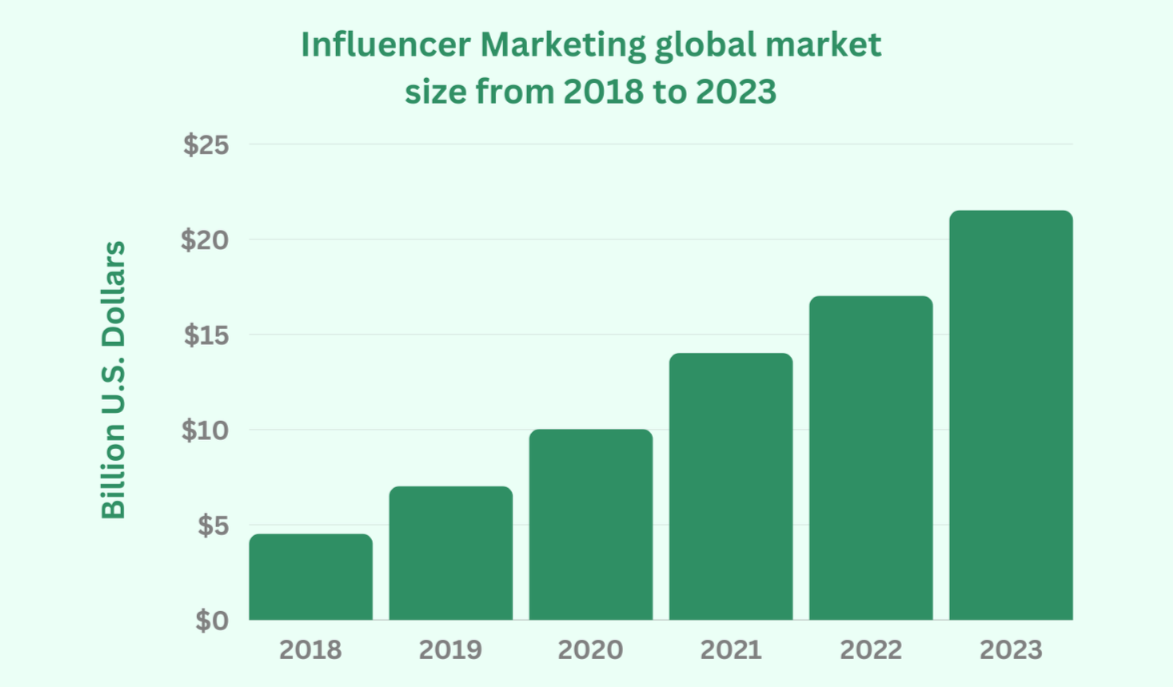
Source: Landon Howell
However, content creators with smaller audiences can effectively use affiliate marketing as long as they are influential in specific, narrow niches. Teaming with micro and nano-influencers may be a cost-effective way to raise brand awareness in specific targeted groups. In 2023, 56% of marketers who use influencer marketing invested in partnering with micro-influencers.
Rapid Brand Awareness
Increasing sales is only one of the immediate benefits of using social media for affiliate marketing. If affiliates bond with the advertised products, they can significantly amplify brand awareness and reputation.
Often, affiliate links are used in the content that serves as product reviews. This approach is more effective than direct advertising, as consumers trust the experiences of influencers they already respect. Additionally, most social media platforms allow posting questions and opinions for interacting with content creators, driving more user engagement.
As for the speed of spreading brand awareness, it’s exactly the nature of social media platforms, where developers design features to ensure content spreads rapidly. The right content can reach far beyond its original audience through reposts and maintain engagement over a long period.
Easily Trackable ROI
Businesses can customize their social media affiliate programs to track multiple performance metrics, including clicks, impressions, and user and content creator statistics. Tracking and analyzing these data helps evaluate and optimize the affiliate marketing strategy’s effectiveness. The key aspects to consider for return on investment evaluation are:
- Conversion rates: Track the number of conversions each click on the link drives to understand which payment models work best for your business.
- Engagement metrics: Track how people engage with content containing affiliate links through reactions, impressions, comments, and reposts. This will help evaluate the influencer’s effectiveness.
- Click-through rates: Analyze the percentage of users who click your links against the total number of viewers. A higher CTR suggests that the links are exposed to a well-targeted audience.
- Customer acquisition cost: Calculate the price for acquiring a customer through social media affiliate marketing efforts. Use this information to define the best social media for affiliate marketing and compare them to other marketing channels.
Performance-Based Marketing
With various commission models, affiliate social media marketing allows for assigning different conversion actions for which the affiliate is paid. For example, marketing campaigns focusing on sales leverage CPA models where the commissions are paid per sale. Consequently, if the affiliate shows few sales, the advertiser’s expenses decrease proportionally.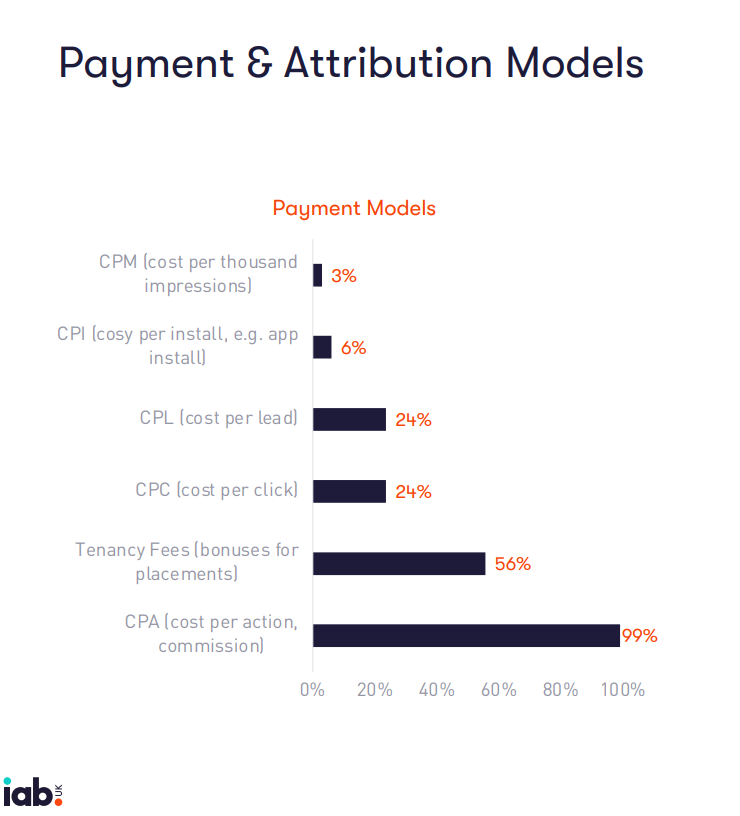
Source: IAB UK
The cost-per-action method, which includes paying per sale, is used by almost every company involved in affiliate marketing. Brands determined to improve their reputation and visibility can use other methods or combine them in different social media affiliate marketing campaigns.
Affiliate marketing is a valuable strategy for both large and small companies, as it minimizes the risk of spending money without achieving tangible results. Once initial outcomes are observed, companies can assess whether to continue with the current strategy or adjust their approach, all without having exhausted their entire advertising budget.
Precise Targeting
Using social media for affiliate marketing is ideal for precise targeting. Advertisers can set specific goals, such as paying for clicks or users landing on their product pages. Only users interested in the product are most likely to perform target actions after seeing the relevant content where the affiliate link was embedded.
Secondly, social media platforms offer mechanisms for targeting specific audience segments. Consider that different platforms already attract different demographics. For example, TikTok is favored by the younger generation, LinkedIn speaks to the professional crowd, and Pinterest has the majority of female users. Furthermore, partnering with different social media influencers provides access to their specific audiences, which businesses can explore through their reactions to the content or directly requiring from an affiliate.
Social Media Affiliate Marketing Best Practices and Tips
Any business involved in digital marketing can use the benefits of affiliate marketing with social media. However, choosing the optimal platform, finding content creators with appropriate target audiences, and understanding the different payment models are crucial to starting social media affiliate marketing on the right foot.
The following best practices and tips will help you learn how to make money with affiliate marketing, whether you are a content creator or an advertiser or represent an affiliate agency starting to conquer the social media field.
How to Define the Best Social Media Platforms for Affiliate Marketing
Affiliate marketing can only be used on platforms that:
- a) allow it by inserting affiliate links and
- b) have an audience that is accustomed to shopping on them or engaging with product reviews or promotions.
Ensure that the social media platform of your choice allows affiliate links. Platform policies may vary; they may allow links only if embedded in identical text anchors, permit a certain number of links per post, or restrict links in published content but allow them in the account description or profile bio. Consider whether the available options align with the social media affiliate programs you participate in.
When asked about the social media platforms where they are most likely to shop, most users across all generations name Meta’s Facebook and Instagram as their top choices. YouTube, TikTok, and Pinterest are the runner-ups.
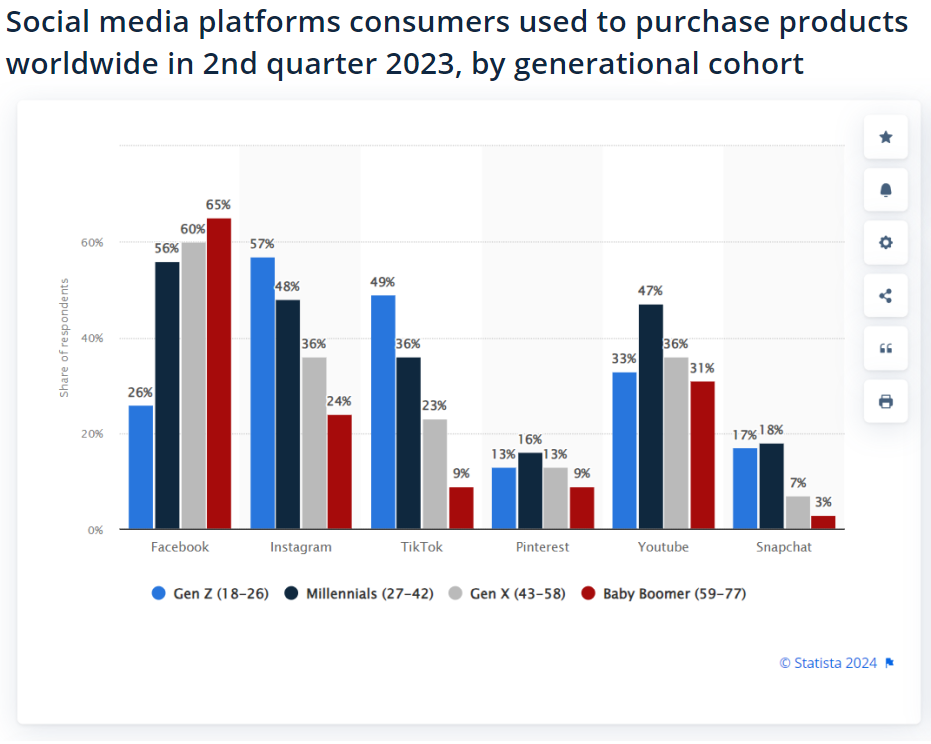
Source: Statista
How to Optimize Social Media Affiliate Strategies
The advantages of using social media for affiliate marketing include granular control over advertising expenses and access to various metrics to evaluate effectiveness. It’s important to monitor the performance of your affiliate marketing online campaigns and use the available data to perfect your strategies.
Many variables can be adjusted, from small details in your campaigns to switching partnerships or platforms:
- Evaluate the effectiveness of different compensation models. For instance, compare the ROI of campaigns with the pay-per-sale model versus pay-per-click to find out which brings more profit, paying a higher commission for sales or a lower commission for warm leads.
- Create partnerships with influencers that provide the most conversions. Track how many leads or sales each influencer drives, analyze the engagement rates of their content, and study their audience’s demographics. Learn your lessons and engage in more effective partnerships next time.
Examine which type of content is the most effective for your affiliate links. Depending on the type of product promoted, choose between long and short-form texts, video descriptions, image captions, and profile bios. For instance, software products require lengthy YouTube reviews, and the descriptions under videos are ideal for affiliate links. Conversely, short videos or image captions are better suited for affiliate marketing businesses promoting visual products.

Source: YouTube
- Use affiliate management tools to gain insights into customer behavior and identify the ideal customer profile. Understanding which users resonate with the products will help enhance advertising campaigns, create guides for finding more effective affiliate channels, and even provide hints that may help improve the product itself.
How to Engage in Social Media Affiliate Marketing Without Posting Affiliate Links
There are times when affiliates can only post a limited number of links or are prohibited from posting affiliate links altogether. For instance, LinkedIn has a policy prohibiting misleading links, requiring that links appear on the front end exactly as they are. Consequently, affiliate links with their codes may appear untrustworthy to users who may prefer to avoid clicking them. Additionally, LinkedIn may penalize posts with too many links, decreasing their visibility. Another example is TikTok, which allows users to post only one link per account.
In such cases, instead of the affiliate links, affiliates may post links to their websites, YouTube review channels, or Facebook blogs, with content optimized for affiliate marketing. This cross-platform approach allows them to drive traffic between various channels, enhancing their affiliate marketing efforts.
When promoting affiliate links to B2B product pages, it may be effective to target professional audience segments through LinkedIn accounts. On the other hand, for social media affiliate campaigns requiring long video reviews of packages offered by travel agencies, partnering with a popular TikTok channel is optimal. This strategy can drive the younger crowd interested in traveling to the YouTube channel.
How to Do Affiliate Marketing on Pinterest
When examining various social media platforms for affiliate marketing, it’s important to find one that attracts an audience that resonates with your brand. Pinterest is a visual-based social network often used for B2C advertising. Users sign up and visit it for inspiration in home decor, fashion, recipes, travel, DIY projects, and more. The platform has taken serious steps to specifically target users “looking for new brands and new ideas.”
Pinterest allows the promotion of products or services to narrow niche communities circled around content creators. Posting affiliate links on Pinterest can be done through image and video descriptions, but first, ensure to follow these Pinterest affiliate marketing advice:
- Establish a business account that will include the necessary management features for doing affiliate marketing through Pinterest, such as advanced analytics and tracking
- Create Pinterest Pins that allow adding a link field to the product image or video
- Explore and follow Pinterest affiliate marketing rules that prohibit spamming on a platform and promote transparent product advertising
Join social media marketing affiliate programs that align with Pinterest rules that, for example, demand posting original content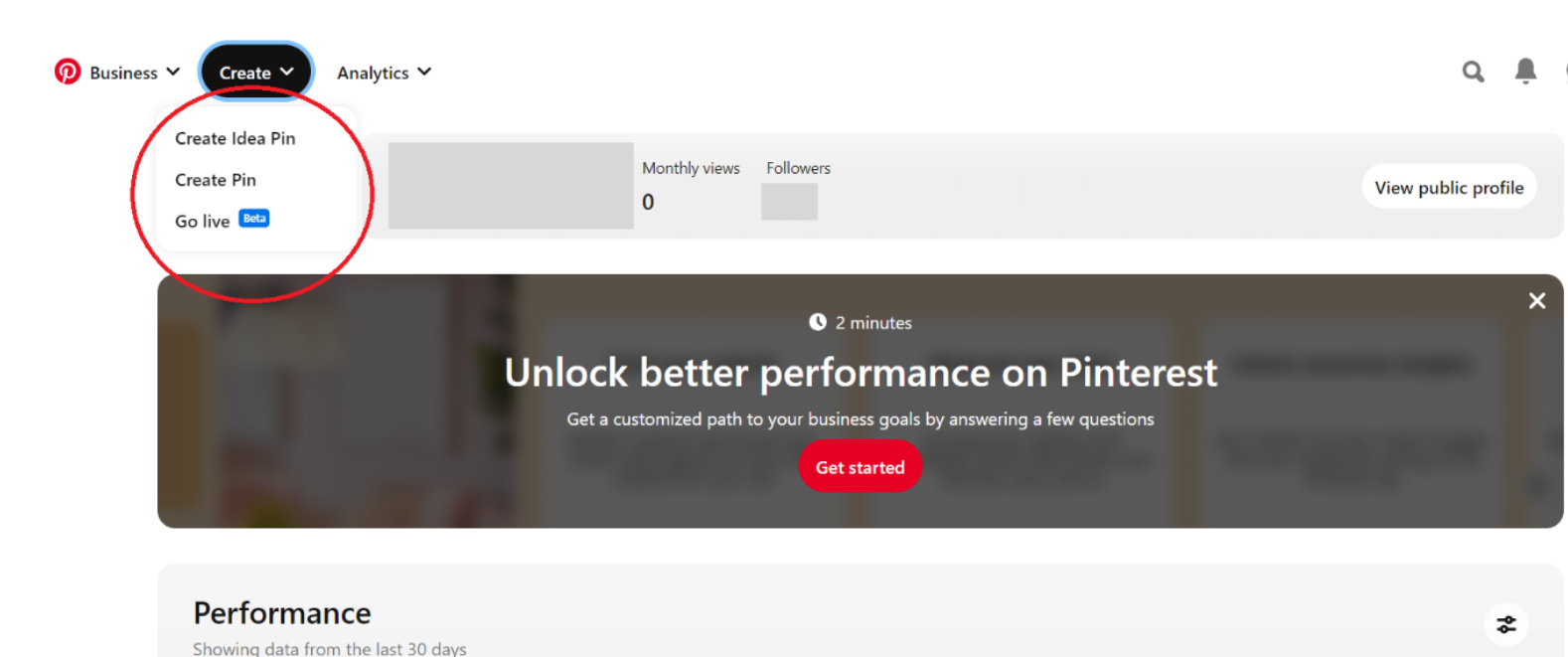
Source: Pinterest
How to Use TikTok for Affiliate Marketing
TikTok is a social media platform with short video content that predominantly attracts a younger public. This social networking service has shown the highest increase in user numbers in the US from 2021 to 2023, among other social platforms, and this trend will probably continue into 2024. This is why it is wise to consider TikTok for affiliate marketing today, to explore its benefits, and to optimize affiliate strategies.
Key factors to consider when deciding to use TikTok for affiliate marketing include:
- Evaluate the demographic reach that TikTok provides. Besides its popularity among the younger generation, more women use it than men and more Hispanic adults use it than Black and Asian adults and even fewer White adults.
- TikTok algorithms favor viral content. Short videos spread rapidly, but their lifespan is short.
- Content creators with a higher number of followers reach wider audiences but the percentage of users viewing their videos is smaller
- The most engaging content on TikTok is from the industries that provide visually appealing products or cater to users’ personal interests and passions, such as travel, food, and beauty.
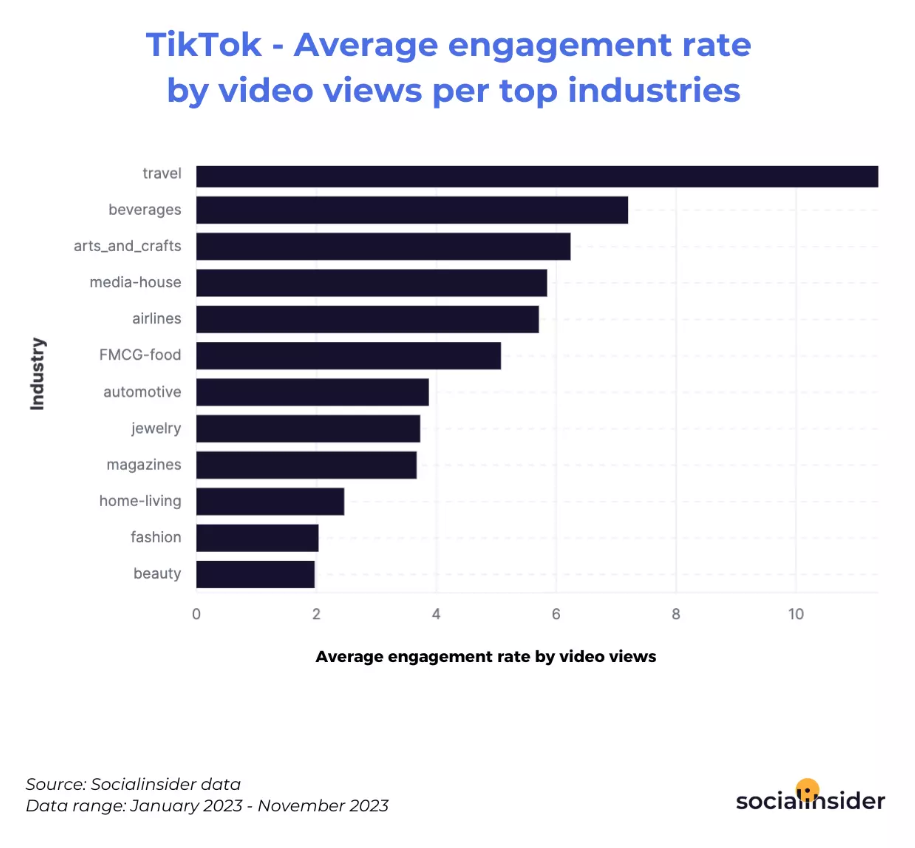
Source: Social Insider
To engage in TikTok affiliate marketing, follow these simple steps:
- Upgrade to a business account, which allows inserting one link into your profile bio. In TikTok, affiliate links cannot be attached to each video.
- Insert an affiliate link in the bio if you promote one product with your account.
- Insert a link to your website or other media channel with multiple affiliate links.
Joining Trusted Affiliate Networks
Social media and affiliate marketing form a powerful combination. Affiliate marketing without social media offers robust metrics and a reliable payment system but lacks precision in targeting and reach. Conversely, social media advertising without affiliate marketing integration is more expensive, less effective, and unpredictable.
If your business requires immediate assistance to obtain traffic from target customers, join an affiliate network with an impeccable reputation and top-notch affiliate management tools. Zero Parallel offers a dynamic platform equipped with advanced filters and robust analytics, delivering exclusive, high-quality leads, including those gathered through social media affiliate marketing.
Frequently Asked Questions
What is affiliate marketing and how does it work?
Affiliate marketing is a performance-based advertising strategy. Typically, it involves incorporating trackable affiliate links within the text that lead potential customers to the product page with the possibility of purchasing and rewarding publishers with commissions according to the chosen payback model.
How to use Pinterest for affiliate marketing
Pinterest is one of the top five social media platforms used for eCommerce. It is best suited for promoting B2C products, such as home decor, suppliances, fashion items, travel services, and DIY instruments. Using Pinterest for affiliate marketing requires starting a business account, creating product pins, and adhering to Pinterest affiliate marketing rules.
Can I do Amazon affiliate marketing on Pinterest?
You can pin Amazon affiliate links to your Pinterest posts. To obtain such links, sign up for the Amazone Associates marketing program.
Which social media is best for affiliate marketing?
Finding the best social media platform depends on the type of products being promoted, as they may require specific content or audiences. It’s also important to understand which social media platforms are most popular for shopping or for seeking information to help users buy products. The top five such platforms are Facebook, Instagram, Pinterest, TikTok, and YouTube.
Can you do affiliate marketing on TikTok?
TikTok limits the usage of links to one link per account, only in the account description, and only for business accounts. To engage in affiliate marketing, TikTok users can post only one affiliate link or link their account to a website or other marketing channel where they can promote many affiliate products.


